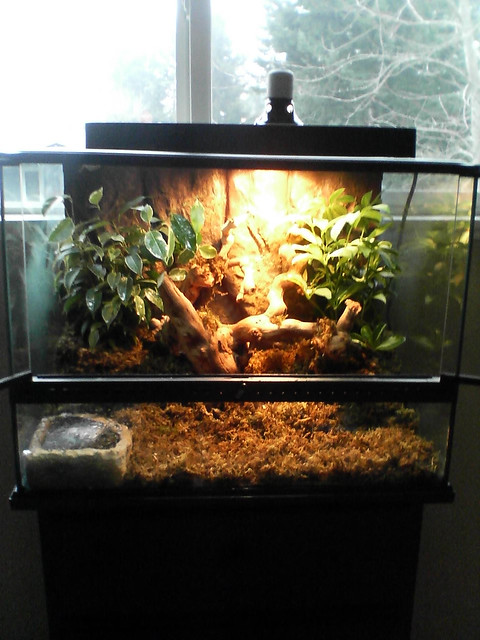Spiderlash
New Member
I have worked at a locally owned pet shop for almost four years and it has really broadened my horizons for pet knowledge/care. I thought about getting a bearded dragon for a long time, but decided it was too generic for me. So I went out on a limb and decided to hold out for a panther chameleon - my favorite species of cham.
My patients paid off and two months ago I purchased a captive bred three-month-old blue-bar ambilobe panther chameleon. His name is Nebulas. He is about 5 months old right now and is aprox. 6" long from nose to tail. Neb has an excellent appetite (eats approx. 5 doz 3-wk crickets a week), is shedding normally and has no visible signs of stress or illness. I try to handle him at least a couple times a week in 5 - 10 minute intervals to keep him tame while not putting too much stress on him. This is my first reptile I have ever personally owned (other than caring for the ones at the shop), and with the last year and a half managing the Fish & Reptile Room, I'm finding it fun and rewarding - and I'm loving it!
Neb is currently in a 24"x18"x18" Exo-Terra glass terrarium (pictured below). I know he will soon out-grow this - but don't worry - I have easy access to larger enclosures for the future through my work.
This is a shot of his tank the first week - two months ago:

Neb Setup - First Week by ..:: Hilary ::.., on Flickr
And here's little Neb at about 4 inches - taken two months ago:

Because I can by ..:: Hilary ::.., on Flickr
I am interested in creating a self-sustaining ecosystem/natural terrarium in his current enclosure. I have both a small ficus and schefflera in pots covered with moss to create the illusion of being planted in the substrate. But I would like to take them out of the pots, and create a more natural environment for him to live in. I've also been thinking of building a screen enclosure to set on the top of his current tank for more climbing room/better ventilation.
The book I own (Natural Terrariums, by Phillip Purser) suggests the substrate mixture for a jungle terrarium as follows:
- 1 part coir (ground coconut husk)
- 2 parts orchid bark
- 2 parts composting leaves
- 1 part ground palm
- augment with 2 Tbs. general purpose organic fertilizer and 2 Tbs. trace elements to kick-start the live bacteria.
I was able to easily find and purchase the coir and orchid bark, but I'm having trouble locating good sources to purchase the others.
Any suggestions on where I can find composting leaves, ground palm, general purpose organic fertilizer and trace elements? These have me stumped.
Or other things that are more readily available/serve the same purpose?
Any suggestions/comments are welcome and encouraged!
Thanks!
~Hilary
My patients paid off and two months ago I purchased a captive bred three-month-old blue-bar ambilobe panther chameleon. His name is Nebulas. He is about 5 months old right now and is aprox. 6" long from nose to tail. Neb has an excellent appetite (eats approx. 5 doz 3-wk crickets a week), is shedding normally and has no visible signs of stress or illness. I try to handle him at least a couple times a week in 5 - 10 minute intervals to keep him tame while not putting too much stress on him. This is my first reptile I have ever personally owned (other than caring for the ones at the shop), and with the last year and a half managing the Fish & Reptile Room, I'm finding it fun and rewarding - and I'm loving it!
Neb is currently in a 24"x18"x18" Exo-Terra glass terrarium (pictured below). I know he will soon out-grow this - but don't worry - I have easy access to larger enclosures for the future through my work.
This is a shot of his tank the first week - two months ago:

Neb Setup - First Week by ..:: Hilary ::.., on Flickr
And here's little Neb at about 4 inches - taken two months ago:

Because I can by ..:: Hilary ::.., on Flickr
I am interested in creating a self-sustaining ecosystem/natural terrarium in his current enclosure. I have both a small ficus and schefflera in pots covered with moss to create the illusion of being planted in the substrate. But I would like to take them out of the pots, and create a more natural environment for him to live in. I've also been thinking of building a screen enclosure to set on the top of his current tank for more climbing room/better ventilation.
The book I own (Natural Terrariums, by Phillip Purser) suggests the substrate mixture for a jungle terrarium as follows:
- 1 part coir (ground coconut husk)
- 2 parts orchid bark
- 2 parts composting leaves
- 1 part ground palm
- augment with 2 Tbs. general purpose organic fertilizer and 2 Tbs. trace elements to kick-start the live bacteria.
I was able to easily find and purchase the coir and orchid bark, but I'm having trouble locating good sources to purchase the others.
Any suggestions on where I can find composting leaves, ground palm, general purpose organic fertilizer and trace elements? These have me stumped.
Or other things that are more readily available/serve the same purpose?
Any suggestions/comments are welcome and encouraged!
Thanks!
~Hilary







